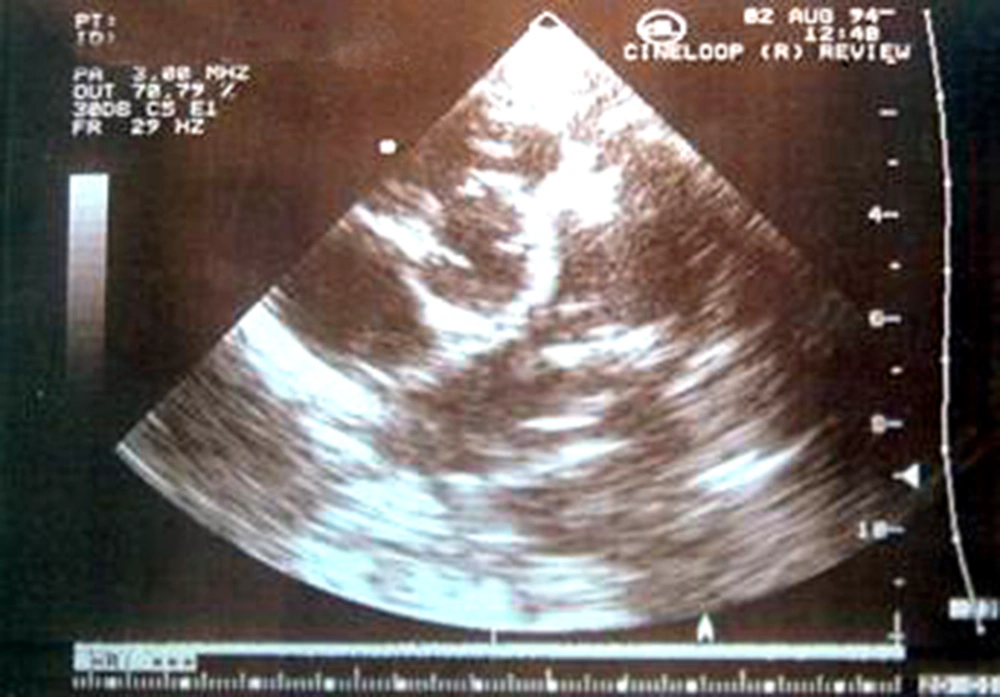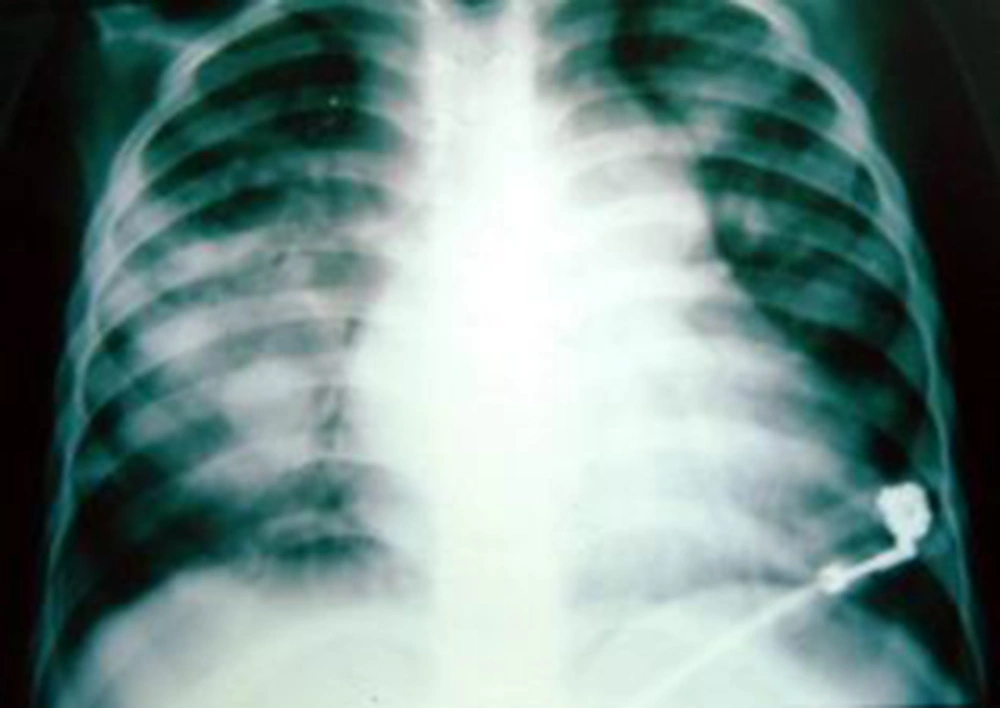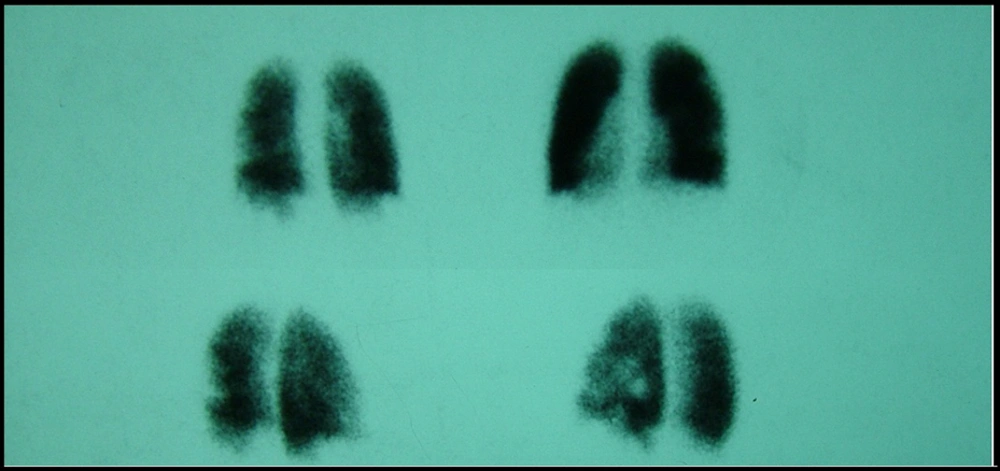1. Introduction
The incidence of infective endocarditis (IE) in pediatric patients is lower than in adults, occurring at a rate of 0.34 - 0.64 per 100,000 per year (1). It can causes morbidity and mortality in 7 - 25% of cases (2). Endocarditis in the right chambers of the heart is more common in children with congenital heart disease (CHD), whereas left-sided IE is more common in adult patients with acquired heart disease. The responsible pathogen in pediatric IE is usually Gram-positive cocci (3). Right-sided endocarditis was reported in 5 – 10% of IE cases. Intravascular devices, and drug addiction, are other predisposing risk factors for right-sided IE (4). Endocarditis is a severe complication in CHD. In a series of 45 cases of IE (age: 8 months to 35 years), the most frequent CHD was VSD (31%) followed by tetralogy of fallot (19%) and atrioventricular septal defects (11%) (5). Morbidity of IE was defined as any mycotic aneurysm, septic emboli, stroke, or abscess at the time of the diagnosis of disease (6). When right-sided IE is present, pulmonary embolism with or without infarction, acute pneumonia, pleural effusion, or emphysema is common. Pulmonary septic embolus is defined as the embolization of septic thrombi from a primary infectious site into the pulmonary circulation. An extra pulmonary focus of infection like cardiac vegetation causes extravasations and the translocation of organisms, and bacteria can enter into the pulmonary circulation. When pathogens enter the blood stream, they can produce direct injury by toxins, or indirect insults by inflammatory mediators leading to local thrombosis and subsequent focus for the multiplying of pathogens. Septic emboli in pulmonary circulation results in the metastatic infection of lung parenchyma. Staphylococcus aureus is a leading pathogen because it can produce toxins and enzymes, leading to severe infection as well as endothelial damage (7). Large vegetation is a predisposing factor for embolization (3). The aim of the present study was to introduce a case of septic pulmonary emboli in a child with CHD who acquired infective endocarditis.
2. Case Presentation
A 6-year-old girl was admitted to the hospital due to a one-month history of intermittent high-grade fever. She suffered from an underlying CHD as a large ventricular septal defect (VSD), which resulted in heart failure. She was under treatment with digoxin, furosemide, captopril, and had received intermittent oral antibiotics. No predisposing risk factor such as a dental procedure or surgery was found in her past medical history. At the time of admission, the general condition of the patient was poor. A high-grade fever of 39ºC was measured, and paleness was evident. On cardiac examination, a grade 4/6 harsh pansystolic murmur at the lower left sternal border and a loud second heart sound were detected. A systolic thrill was palpable at the lower left sternal border. Localized crackles were audible at the base of the right lung. The spleen was palpable 3 cm below the costal margin. No Osler’s node, splinter hemorrhage, or Janeway’s lesions were noticed. Lab tests showed the following: hemoglobin 8.9 g/dl, leucocytosis (17.6 × mm3) with 85% neutrophils, ESR 97 mm, and C-reactive protein 3 plus positive. Electrocardiography showed sinus tachycardia, a heart axis + 90º, and left ventricular hypertrophy. Chest x-ray revealed moderate cardiomegaly with a prominent pulmonary artery segment and increased pulmonary vascular markings. Transthoracic echocardiography revealed a large perimembranous VSD, and pulmonary artery pressure was 50 mmHg. Large vegetation up to 12 mm was detected at the right ventricular outflow tract adjacent to the pulmonary valve (Figure 1). The diagnosis of IE was considered, and three blood cultures were taken with 1-hour intervals, before the initiation of antibiotics. Treatment was started with oxacillin 200 mg/kg/24 hours/IV in 4 divided doses plus gentamycin 3 mg/kg/24 hours/IV in 3 divided doses. There was no improvement in the patient’s condition, the fever continued, and cough and dyspnea appeared. The results of blood cultures were negative. A repeated chest x-ray showed two rounds, well-defined opacities at the right lower lobe, one of them larger than the other, and their images were projected over each other. A small area of alveolar infiltration was also seen in the apical segment of the left upper lobe (Figure 2). On a perfusion scan of the lungs, an area of perfusion defect was seen in the right lower lobe compatible with the lesions that had been detected in chest X-ray (Figure 3). The diagnosis of septic pulmonary embolism as a complication of right-sided IE was considered, and treatment was changed to vancomycin 40 mg/kg/24 h/ IV in 4 divided doses plus rifampin 900 mg per 24 hour /PO in 3 divided doses, and gentamycin was continued. The general condition of the patient gradually improved, the fever subsided, and ESR was decreased. On a follow-up chest x-ray, the nodular opacities disappeared. On echocardiography, the size of vegetation obviously diminished. Treatment was continued for six weeks. The patient was referred for cardiac surgery, and the VSD was closed successfully. Antibiotic therapy was continued for another 4 weeks, and the patient was discharged with the recommendation of regular follow-up and IE-prophylaxis instructions.
3. Discussion
The diagnosis of IE in this patient was made according to the modified Duke Criteria (8), including one major criterion (vegetation on echocardiography), and three minor criteria (fever, splenomegaly, and high ESR), and she had a VSD, which is the most common CHD. Patients with congenital left-to-right shunts such as VSD are at risk for right-sided IE. The high-pressure gradient between two chambers of the heart results in endocardial damage on the right side. Vegetation usually takes place on the endocardial erosion. There are several case reports of right–sided IE in patients who suffered from a VSD (9-12). In a collaborative study (1997 – 2001) by Niwa et al. 239 Japanese patients with IE (170 children, and 69 adults) were enrolled. The most common CHD were a VSD, a VSD + ASD (atrial septal defect) or PDA (patent ductus arteriosus), and tetralogy of fallot. Left-sided infection was observed in 46% and right-sided in 51%. The order of frequency in right-sided endocarditis was as follows: the tricuspid valve, the right side of the septal defect opening in VSD, the right ventricle free wall or the site of impact of the jet stream, the right ventricle, the right ventricular outflow tract, the pulmonary valve, and the pulmonary artery (3). The results of another study on 104 Indian patients showed that CHD was the most frequent underlying disease and a VSD was the most common CHD. Predisposing factors for the evolution of IE were found in only 19 (18.2%) patients (13). In a 2-year (2010 – 2011) study from Burkina Faso, 14 cases of right-sided IE were reported. Fifty percent (7 cased) were children and six of seven had CHD. Blood cultures were positive in 11 cases and bacteria consisted of streptococcus pneumonia (6), staphylococcus aureus (3), and hemophilus influenza (2), respectively (4). In Niwa’s study, three samples of blood culture within 24 hour were adequate for evaluation, and the frequency of positive blood culture varied from 68 to 98% and previous administration of antibiotics decreased the above rate to 60% (3). The responsible bacterium in the presented case was likely staphylococcus aureus, but she had received oral antibiotics before admission, and this may be a reason for her negative blood culture. Right-sided IE usually involves the tricuspid valve. Pulmonary valve IE is rarer than tricuspid valve IE, accounting for less than 2% of IE patients in hospitals, and the majority of cases occurred in CHD. Pulmonary valve IE may be due to the jet of a VSD’s turbulent flow and its extension towards the pulmonary valve. The first clinical presentation is usually pulmonary infection in the lower lobes due to septic emboli (9). A study by Naidoo et al. from South Africa on 15 non-addict cases of right-sided IE showed nine patients with tricuspid valve involvement. Staphylococcus aureus was the most frequent bacteria isolated from seven blood cultures. Right lower lobe pneumonia, such as consolidation with cavitation, was the prominent clinical feature (14). A sixteen-year study (1950 – 2011) was conducted at the Mayo Clinic, and 97 children with IE in two separate cohorts were enrolled. Seventy-seven percent had CHD. Complications such as septic emboli, mycotic aneurysm, and abscess were noted in 33% of patients (6). In our patient, the vegetation was located in the right ventricular outflow tract, very close to the pulmonary valve, and bacteria, likely staphylococcus, could readily reach the lungs. The connection between pulmonary septic emboli and right-sided IE is well recognized. It is diagnosed using radiologic tests. The best radiologic procedure is CT scan, which demonstrates that typical cavitation in peripheral nodular lesions and multiple emboli is common (15). A retrospective study (2000 – 2013) was conducted on 40 patients with pulmonary septic emboli. The mean age of patients was 46 years (17 – 71 years). The most common sources of infection were skin and soft tissue (44%), infective endocarditis (27%), and peripheral deep vein thrombosis (17%). Bacteremia in 85% of cases was due to staphylococcus aureus. The locations of vegetation in 11 cases of IE were as follows: the tricuspid valve (8), the mitral valve (2), and the pulmonary valve (1). All the patients had peripheral nodular consolidation in chest x ray. lung CT scans of all patients showed nodular lesions, in 71% of cases this was associated with cavitation, and 54% showed non-nodular infiltration, such as a grand glass appearance. The resolution of typical radiologic lesions with antibiotic therapy confirms the diagnosis. The mean course of treatment was 6 weeks (3 – 12 weeks) (7). The perfusion scan for our patient was suggested by a radiologist and showed the typical radiologic picture of septic emboli. In a study by Di Filippo et al. 36 children with endocarditis were included. Twenty-six had an isolated VSD and 10 had a VSD associated with a minor lesion. The most frequent site for vegetation was the tricuspid valve (10 cases). Multiple embolizations were observed in 60% of right heart endocarditis, and a single embolus was noted in 55% of left heart endocarditis (16). A sample of 50 children with endocarditis (age: 4 months to 12 years) were reviewed retrospectively during a period of five years. CHD was the underlying disease in 44 cases. Embolic events were more common when vegetation was present in the right-sided valves or chambers. Large vegetation (more than 10 mm) was a predictor for embolization (17). The size of vegetation in our patient was 12 mm. In a cohort of 287 patients with 300 episodes of IE, septic pulmonary embolism occurred in 26 cases. Cardiac complications were the most common findings, but fatality rates were higher for neurologic and septic complications (18). Patients with CHD and IE show a broad clinical spectrum of cardiac and extracardiac complications. Data from 52 patients with endocarditis grown up with CHD showed embolism of the pulmonary arteries in 7.7% of cases. Staphylococcus (38.9%) and streptococcus (35.2%) were the most grown bacteria (19). Early surgical intervention should be considered in patients with right-sided infective endocarditis and subsequent septic pulmonary emboli (20). Our presented patient was a kind of neglected case. She was on a long waiting list for cardiac surgery. The parents were unaware of regular follow-up. When the child became febrile and was taken to different clinics, she received several types of antibiotics without further work-up. Long-term febrile illness in a child with CHD should suggest the diagnosis of IE and admission to a hospital. In this case, the occurrence of pulmonary symptoms was due to pulmonary embolization, and the diagnosis of septic emboli was suspected according to clinical, radiographic, and pulmonary perfusion scan findings. After adequate antibiotic therapy, the patient underwent cardiac surgery for the closure of the VSD. The diagnosis of septic pulmonary emboli should be suspected in a feverish endocarditis case with an insidious onset of symptoms of lung involvement. Bacteriologic diagnosis may be impaired due to previous antibiotic therapy. Chest x-ray, lung CT scan, and the resolution of radiologic features by antibacterial treatment confirm the diagnosis.


